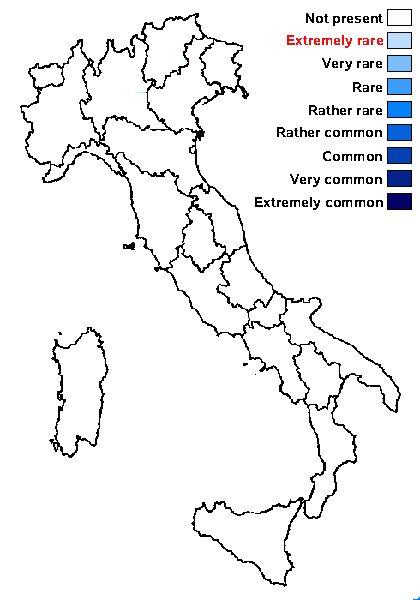Pyrenopsis picina (Nyl.) Forssell
Nova Acta R. Soc. Scient. Upsal., Ser. 3 ,13, 6: 45, 1885. Basionym: Synalissa picina Nyl. - Act. Soc. linn. Bordeaux, 21, 4: 265, 1857 (1856)
Synonyms:
Distribution:
Description: Thallus crustose, thinly episubstratic and film-like, effuse and poorly delimited, continuous to finely rimose, black when dry, dark reddish brown when wet. Apothecia immersed, perithecioid, 0.1-0.2 mm across, with a punctiform disc. Proper exciple poorly developed; epithecium grey-brown; hymenium colourless, I+ deep blue; paraphyses sparingly branched and anastomosing, 1-1.5 µm thick; hypothecium colourless. Asci (16-)24-32-spored, broadly clavate, functionally unitunicate, with a strongly amyloid cap, Ascospores 1-celled, hyaline, ellipsoid, 4-6(-7) x 3-4(-5) µm, Pycnidia immersed. Conidia thread-like. Photobiont cyanobacterial, chroococcoid (Gloeocapsa), the cells surrounded by a reddish-violet gelatinous sheath. Spot tests: all negative. Chemistry: without lichen substancesNote: a species close to P. grumulifera, from which it is not always distinguished, but with an effuse, thin, black thallus overgrowing mosses on humid siliceous rocks; overall distribution poorly known, with a few records from the Western Alps (France). To be looked for in Italy.
Growth form: Crustose
Substrata: rocks, soil, terricolous mosses, and plant debris
Photobiont: cyanobacteria, coccaceous (e.g. Gloeocapsa)
Reproductive strategy: mainly sexual

Predictive model
Growth form: Crustose
Substrata: rocks, soil, terricolous mosses, and plant debris
Photobiont: cyanobacteria, coccaceous (e.g. Gloeocapsa)
Reproductive strategy: mainly sexual

Predictive model
 Index Fungorum
Index Fungorum
 GBIF
GBIF

